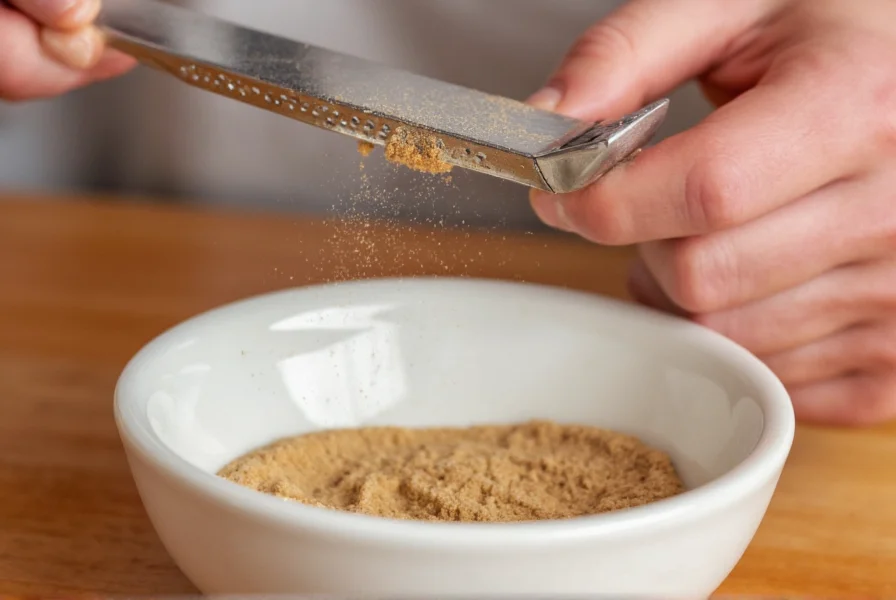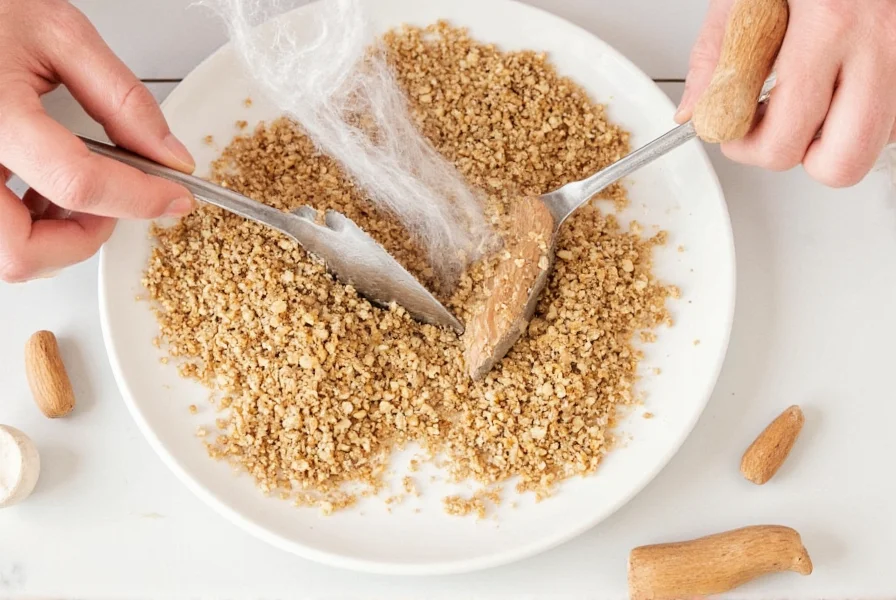There's a reason professional chefs always reach for whole nutmeg rather than the pre-ground version in the spice aisle. Freshly grated nutmeg delivers a complex, warm aroma and nuanced flavor that simply can't be matched by its shelf-stable counterpart. The volatile oils that give nutmeg its distinctive character evaporate quickly once ground, which is why taking the time to grate your own makes such a dramatic difference in both sweet and savory dishes.
Essential Tools for Grating Nutmeg
While a microplane is the gold standard for grating nutmeg, several alternatives work well depending on what's available in your kitchen:
| Tool | Best For | Texture Result | Efficiency Rating |
|---|---|---|---|
| Microplane zester | Most applications | Fine, fluffy texture | ★★★★★ |
| Box grater (smallest holes) | When microplane unavailable | Slightly coarser | ★★★☆☆ |
| Pepper mill (nutmeg-specific) | Convenience | Moderately fine | ★★★☆☆ |
| Coffee grinder (dedicated) | Large quantities | Very fine powder | ★★☆☆☆ |
Step-by-Step: How to Grate Nutmeg Properly
Follow these steps for optimal results when learning how to grate nutmeg:
- Prepare your workspace: Place a small bowl under your grating surface to catch the precious spice. Nutmeg powder easily scatters, so working over a contained area prevents waste.
- Secure your nutmeg: Hold the whole nutmeg firmly between your thumb and fingers. For better grip, wrap a paper towel around particularly slippery pieces. This technique for holding nutmeg while grating prevents accidents and ensures control.
- Position your grater: Hold the microplane at a 45-degree angle to the nutmeg. This angle provides optimal contact without excessive pressure.
- Grate with short strokes: Use brief, downward motions rather than long pulls. This method for grating nutmeg extracts maximum flavor while minimizing clogging.
- Rotate frequently: Turn the nutmeg regularly to expose fresh surfaces. This ensures even grating and prevents creating flat spots that reduce efficiency.
- Measure carefully: One whole nutmeg yields approximately 2 teaspoons of freshly grated spice. When substituting in recipes, use 1/4 teaspoon of fresh grated nutmeg for every 1/8 teaspoon of pre-ground called for.

Safety Tips for Grating Nutmeg
Nutmeg's small size and smooth surface make it potentially slippery during grating. To avoid injury:
- Always grate away from your body and fingers
- Use a paper towel or kitchen cloth for better grip when the nutmeg becomes oily
- Stop grating when the nutmeg piece becomes too small to hold safely (typically when smaller than your thumbnail)
- Consider using a nutmeg holder tool for added safety if you frequently work with whole nutmeg
Why Freshly Grated Nutmeg Outperforms Pre-Ground
The flavor difference between freshly grated nutmeg and pre-ground versions isn't just subtle—it's transformative. Whole nutmeg retains its essential oils and aromatic compounds until the moment you grate it. Studies show that ground nutmeg loses up to 50% of its volatile compounds within one week of grinding, with further degradation over time.
When comparing freshly grated nutmeg vs pre-ground in blind taste tests, culinary professionals consistently identify the fresh version as having:
- More complex, floral notes
- Warmer, more rounded flavor profile
- Less bitter aftertaste
- Longer-lasting aroma in finished dishes
Storing Leftover Whole Nutmeg
Proper storage maintains your whole nutmeg's potency for future use. Store unused portions in an airtight container away from light and heat. A small glass jar in your pantry keeps nutmeg fresh for up to two years. For extended storage (up to five years), keep whole nutmeg in the freezer—just be sure to return it to room temperature before grating to prevent condensation.
Never store whole nutmeg in the refrigerator, as the humidity causes the spice to absorb moisture, making it difficult to grate and potentially developing mold.
Common Mistakes to Avoid
When learning how to grate nutmeg without a grater, many home cooks make these preventable errors:
- Using excessive pressure: Heavy-handed grating creates heat that can burn the spice and alter its flavor
- Grating directly onto food: Always grate into a separate container to control quantity and prevent waste
- Using a coffee grinder not dedicated to spices: Nutmeg's oils can coat grinder blades and transfer flavors to coffee
- Storing grated nutmeg long-term: Freshly grated nutmeg begins losing potency immediately—grate only what you need

Perfect Pairings: Recipes That Shine with Fresh Nutmeg
Certain dishes particularly benefit from the superior flavor of freshly grated nutmeg. Consider using your newly acquired grating skills for:
- Béchamel sauce: Just a pinch elevates this classic French white sauce
- Butternut squash soup: Complements the natural sweetness perfectly
- Apple pie filling: Adds complexity to traditional fall flavors
- Ricotta pancakes: A secret ingredient that transforms breakfast
- Brussels sprouts with bacon: Creates a sophisticated side dish
FAQ: Frequently Asked Questions About Grating Nutmeg
How much grated nutmeg equals one whole nutmeg?
One whole nutmeg typically yields about 2 teaspoons of freshly grated spice. When substituting in recipes, use a 2:1 ratio—meaning 1/4 teaspoon of fresh grated nutmeg replaces 1/8 teaspoon of pre-ground nutmeg for optimal flavor balance.
Can I grate nutmeg without a microplane?
Yes, you can grate nutmeg without a microplane using alternative methods. The smallest holes on a box grater work reasonably well, though the texture will be slightly coarser. A dedicated nutmeg mill provides convenience, while a coffee grinder (preferably one used only for spices) can handle larger quantities. For emergency situations, you can even use the edge of a fork to scrape small amounts.
Why does freshly grated nutmeg taste better than pre-ground?
Freshly grated nutmeg tastes significantly better because the essential oils and aromatic compounds remain intact until the moment of grating. Pre-ground nutmeg begins losing its volatile compounds immediately after processing, with studies showing up to 50% flavor degradation within one week. The result is a more complex, floral, and warm flavor profile in freshly grated versions compared to the flat, sometimes bitter taste of older pre-ground spice.
How do I prevent nutmeg from slipping while grating?
To prevent nutmeg from slipping while grating, wrap a paper towel or kitchen cloth around the spice for better grip. Some cooks lightly score the surface with a knife to create texture, though this isn't necessary with proper technique. Hold the nutmeg between your thumb and fingers with your palm facing away from the grater, and use short, controlled strokes rather than long pulls. If you frequently work with whole nutmeg, consider investing in a dedicated nutmeg holder tool for added safety.
Can I store freshly grated nutmeg for later use?
While possible, storing freshly grated nutmeg isn't recommended for optimal flavor. The spice begins losing its volatile compounds immediately after grating, with noticeable flavor degradation within 24 hours. If you must store it, place the grated nutmeg in an airtight container and keep it in the freezer for up to one week. For best results, grate only the amount needed for your current recipe and store the whole nutmeg properly for future use.











 浙公网安备
33010002000092号
浙公网安备
33010002000092号 浙B2-20120091-4
浙B2-20120091-4